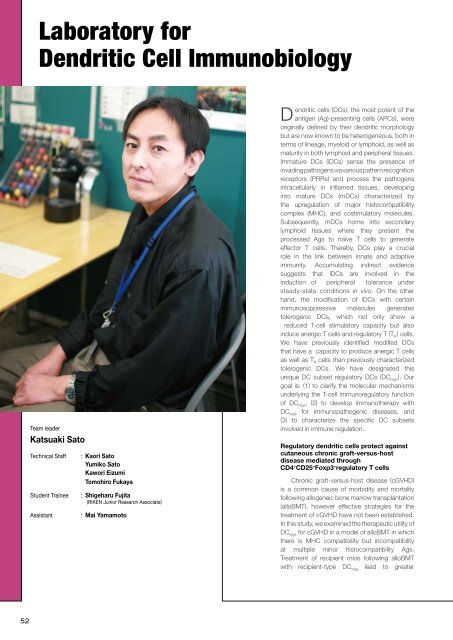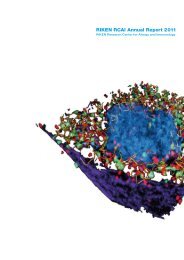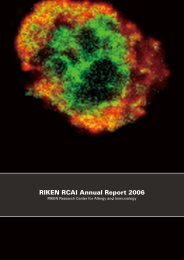in vivo
in vivo
in vivo
You also want an ePaper? Increase the reach of your titles
YUMPU automatically turns print PDFs into web optimized ePapers that Google loves.
Laboratory for<br />
Dendritic Cell Immunobiology<br />
Team leader<br />
Katsuaki Sato<br />
Technical Staff<br />
Student Tra<strong>in</strong>ee<br />
Assistant<br />
: Kaori Sato<br />
Yumiko Sato<br />
Kawori Eizumi<br />
Tomohiro Fukaya<br />
: Shigeharu Fujita<br />
(RIKEN Junior Research Associate)<br />
: Mai Yamamoto<br />
Dendritic cells (DCs), the most potent of the<br />
antigen (Ag)-present<strong>in</strong>g cells (APCs), were<br />
orig<strong>in</strong>ally def<strong>in</strong>ed by their dendritic morphology<br />
but are now known to be heterogeneous, both <strong>in</strong><br />
terms of l<strong>in</strong>eage, myeloid or lymphoid, as well as<br />
maturity <strong>in</strong> both lymphoid and peripheral tissues.<br />
Immature DCs (iDCs) sense the presence of<br />
<strong>in</strong>vad<strong>in</strong>g pathogens via various pattern recognition<br />
receptors (PRRs) and process the pathogens<br />
<strong>in</strong>tracellularly <strong>in</strong> <strong>in</strong>flamed tissues, develop<strong>in</strong>g<br />
<strong>in</strong>to mature DCs (mDCs) characterized by<br />
the upregulation of major histocompatibility<br />
complex (MHC), and costimulatory molecules.<br />
Subsequently, mDCs home <strong>in</strong>to secondary<br />
lymphoid tissues where they present the<br />
processed Ags to naïve T cells to generate<br />
effector T cells. Thereby, DCs play a crucial<br />
role <strong>in</strong> the l<strong>in</strong>k between <strong>in</strong>nate and adaptive<br />
immunity. Accumulat<strong>in</strong>g <strong>in</strong>direct evidence<br />
suggests that iDCs are <strong>in</strong>volved <strong>in</strong> the<br />
<strong>in</strong>duction of peripheral tolerance under<br />
steady-state conditions <strong>in</strong> <strong>vivo</strong>. On the other<br />
hand, the modification of iDCs with certa<strong>in</strong><br />
immunosuppressive molecules generates<br />
tolerogenic DCs, which not only show a<br />
reduced T-cell stimulatory capacity but also<br />
<strong>in</strong>duce anergic T cells and regulatory T (T R<br />
) cells.<br />
We have previously identified modified DCs<br />
that have a capacity to produce anergic T cells<br />
as well as T R cells than previously characterized<br />
tolerogenic DCs. We have designated this<br />
unique DC subset regulatory DCs (DC regs<br />
). Our<br />
goal is: (1) to clarify the molecular mechanisms<br />
underly<strong>in</strong>g the T-cell immunoregulatory function<br />
of DC regs , (2) to develop immunotherapy with<br />
DC regs for immunopathogenic diseases, and<br />
(3) to characterize the specific DC subsets<br />
<strong>in</strong>volved <strong>in</strong> immune regulation.<br />
Regulatory dendritic cells protect aga<strong>in</strong>st<br />
cutaneous chronic graft-versus-host<br />
disease mediated through<br />
CD4 + CD25 + Foxp3 + regulatory T cells<br />
Chronic graft-versus-host disease (cGVHD)<br />
is a common cause of morbidity and mortality<br />
follow<strong>in</strong>g allogeneic bone marrow transplantation<br />
(alloBMT), however effective strategies for the<br />
treatment of cGVHD have not been established.<br />
In this study, we exam<strong>in</strong>ed the therapeutic utility of<br />
DC regs for cGVHD <strong>in</strong> a model of alloBMT <strong>in</strong> which<br />
there is MHC compatibility but <strong>in</strong>compatibility<br />
at multiple m<strong>in</strong>or histocompatibility Ags.<br />
Treatment of recipient mice follow<strong>in</strong>g alloBMT<br />
with recipient-type DC regs lead to greater<br />
52





